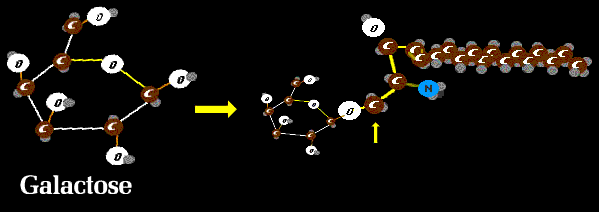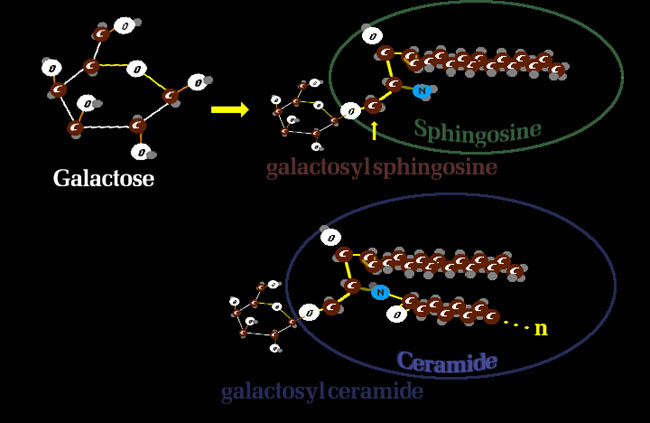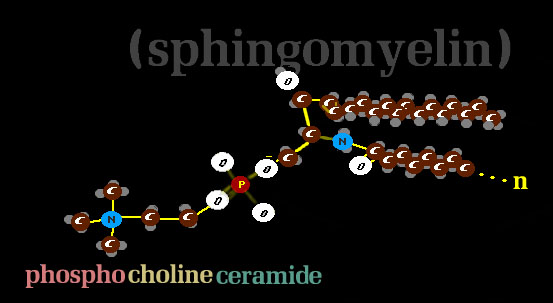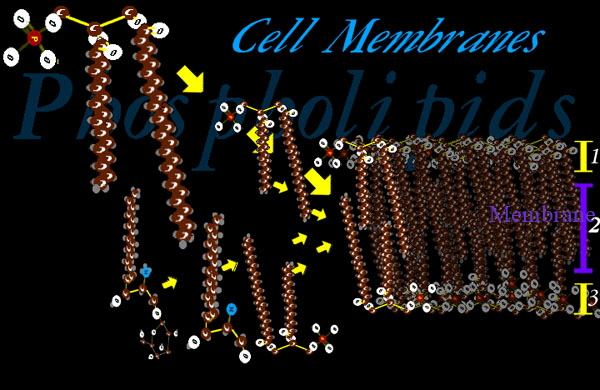 |
|||
|
Membranes
If you want to focus on the industrial aspects of the cell, you must deal with the cell membranes. Cell membranes do not simply divide up activity areas, but serve as controlling mechanisms and as overt doers of function. But first - about form. Lipids are very important. Read about them first.
Fat's (4) are three fatty acids (2) hooked together on an 'E shaped holder (1). If instead of three fatty acids (3) we just use two, and instead of the third fatty acid use a phosphate (5) we get a phospholipid.
Phospholipids:
A single fatty acid - having a knobby water seeking end and a thinner oil tail - will form asterisks * with the water part at the edge and the oil part inside. However, the phospholipid (seen at the left) has a shape that seeks a much more complicated yet water-oil satisfying solution. It is aided in that quest by a number of variations on this theme. These are all similar constructs which slightly vary the water seeking end and/or the oily end such that the final structure has regional properties that can assist certain functions.
Sphingosine uses a sugar similar to glucose (but with the -OH flipped in the other direction) to impart a surface quality and at the same time snips the central lipid and replaces it with a - handy to latch onto - nitrogen group. Many things would like to hold hands with that nitrogen.
Many things including yet another fatty acid. This combo is important enough to get its own name 'Ceramide'. The 'amide' part of the name denotes the nitrogen sitting in there. Sphingosine and the ceramides are not technically listed with the 'phospholipids' because the phospho part was spent in their construction. But hey, who cares. It's all a family business, Phospholipids & Sons - Purveyors of Fine Membranes... as attested to by the very successful and sought out daughter Sphingomyelin (she had her name changed from phosphocholineceramide).
Another player, is cholesterol. A stiff kid from a less flexible family but who has one oil seeking end and one small water seeking cap. Cholesterol stiffens the group when they have a family gathering called a membrane.
H2O ish Oily
H2O ish
Membrane Structures: The membrane encloses the cell itself. How the cell membrane looks to the outside depends on what is attached to that surface (not just galactose, but all sorts of complex carbohydrate and protein toppings can be found). Membrane encloses the nucleus, the DNA compartment, so that DNA can be controlled and not run amok. Holes in the nuclear membrane allow the DNA to be fed through the bars and allow RNA to come and go so as to bring the DNA recipies to the protein machine shops. Out in the cell, glucose (6 carbons) can get broken down to two half glucoses (3 carbons) with enough energy to get by and without need for oxygen. But a long time ago, a neighbor moved in who knew how to burn those half glucose pieces and generate real energy. That small neighbor with its own DNA and with a great recipe for glucose flambe was taken into the fold within its own membrane. Mighty in energy the mitochondria. All that citrate cycle stuff with NAD stored hydrogen getting swapped for ATP, that's all mitochondria business. When cells divide, mitochondria do their own division. As they live in the cell cytoplasm, they only get to go where the cytoplasm goes. So sperm, just DNA with oars, contributes little to mitochondria knowlege. Thus female inheritance exists. That is, the mother passes mitochondria to all the offspring, not half. Disorders of mitochondria will not follow the rules of male female swapped DNA. Lots of balls of RNA, like golf balls on a driving range lawn, sit on sheets of membrane called endoplasmic reticulum, so named because someone was trying very hard to tame a bad stutter and the mouth full of rocks wasn't doing it. I could be wrong about this, though. Each ball has two halves that accept a ticker tape of RNA carried there by other RNA to be read. Each ticker tape code drags in an amino acid holding RNA specific to that code. So the several RNAs working together from an RNA tape join together long sequences of amino acids into proteins. Parts of the proteins, so formed, do a job. But there are additional portions on each protein that tell where the protein is to be taken. The proteins are escorted to specific destinations and those routing slip code portions are snipped off to activate the protein once they are in place. I AM NOT MAKING THIS UP! Often the destination is the outer cell membrane. Once there, the protein alone or with others, gets pushed through the membrane and fixes into place by those handles which we mentioned earlier. Some very long proteins will weave in and out and in about eight times or so, like stitching, through the membrane creating very large membrane function units. Like what? Like spigots. Holes that can open or close. But those holes are filled with amino acid side arms of all sorts of complexity that invite certain things and repel others. A hole may open to invite Potassium, then close over it and push it on through as from the inside another portion was doing a similar but oppositely directed thing to sodium - the potassium-sodium pump. It is a real pump with a real power source (using things like ATP and cAMP). There are Calcium pumps, sugar pumps, and pumps for all sorts of specific complex molecules that need access to the inner cell. In some portions of the cell, nasty stuff, really nasty chemical warefare stuff - like peroxide - is housed in spherical barrels made of membrane. If an enemy attack comes, these barrels will be dumped on the offender. Other things, things not needed by the cell but by other cells or outside jobs are also stowed in membrane sacks - the Golgi docks take in product and ship out containers for export. All in membranes. Membrane surface materials give the needed routing information. For every process mentioned there is an advantage and triumph over the improbable. But for every potential triumph a prospect of failure looms.
|
| [P.O. Home] [Topics] [Muscle] [Basic Science] [Membranes] |
|
|
|
|
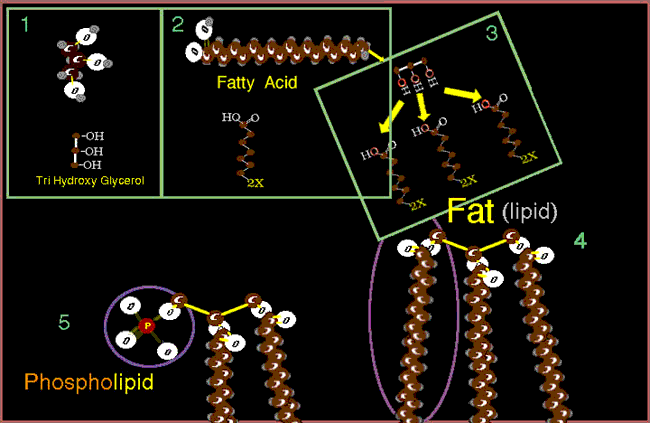
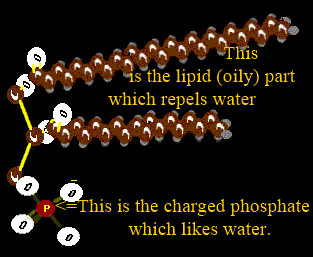 Phospholipids are
Phospholipids are 